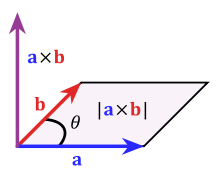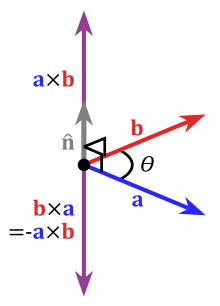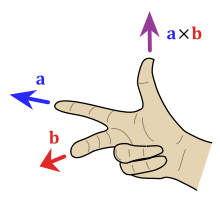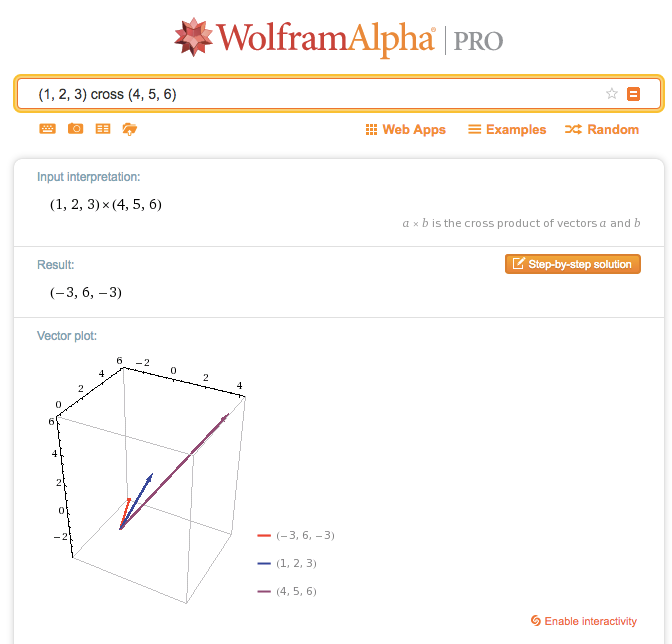How Do You Know if Two Vectors Are Perpendicular or Parallel
Taking 2 vectors, we can write every combination of components in a grid:

This completed grid is the outer production, which can be separated into the:
-
Dot product, the interactions between similar dimensions (
x*x,y*y,z*z) -
Cross product, the interactions betwixt different dimensions (
x*y,y*z,z*10, etc.)
The dot product ($\vec{a} \cdot \vec{b}$) measures similarity because it only accumulates interactions in matching dimensions. Information technology'due south a simple adding with 3 components.
The cantankerous production (written $\vec{a} \times \vec{b}$) has to mensurate a half-dozen "cross interactions". The calculation looks complex but the concept is unproblematic: accrue 6 individual differences for the total divergence.
Instead of thinking "When do I need the cross product?" think "When do I demand interactions between different dimensions?".
Area, for case, is formed by vectors pointing in different directions (the more orthogonal, the better). Indeed, the cross production measures the area spanned by two 3d vectors (source):

(The "cross product" assumes 3d vectors, but the concept extends to college dimensions.)
Did the fundamental intuition click? Let'south hop into the details.
Defining the Cross Product
The dot production represents the similarity between vectors equally a single number:
![]()
For example, nosotros tin say that North and East are 0% similar since $(0, 1) \cdot (1, 0) = 0$. Or that Due north and Northeast are lxx% similar ($\cos(45) = .707$, remember that trig functions are percentages.) The similarity shows the corporeality of one vector that "shows upwards" in the other.
Should the cross product, the difference between vectors, be a single number too?
Let'southward try. Sine is the per centum deviation, and then nosotros could write:
![]()
Unfortunately, nosotros're missing some details. Allow's say we're looking downwardly the x-axis: both y and z signal 100% abroad from us. A number similar "100%" tells us there's a big difference, but we don't know what information technology is! We need actress information to tell us "the difference between $\vec{x}$ and $\vec{y}$ is this" and "the difference between $\vec{x}$ and $\vec{z}$ is that".
So, let's express the cross production every bit a vector:
-
The size of the cross production is the numeric "amount of departure" (with $\sin(\theta)$ as the percentage). Past itself, this doesn't distinguish $\vec{x} \times \vec{y}$ from $\vec{x} \times \vec{z}$.
-
The management of the cross production is based on both inputs: it's the direction orthogonal to both (i.eastward., favoring neither).
Now $\vec{x} \times \vec{y}$ and $\vec{x} \times \vec{z}$ have different results, each with a magnitude indicating they are "100%" different from $\vec{x}$.
(Should the dot production be a vector result too? Well, we're tracking the similarity between $\vec{a}$ and $\vec{b}$. The similarity measures the overlap between the original vector directions, which nosotros already accept.)
Geometric Interpretation
Two vectors determine a airplane, and the cross production points in a direction different from both (source):

Here'southward the problem: there'south two perpendicular directions. By convention, we assume a "right-handed system" (source):

If you lot agree your first two fingers like the diagram shows, your thumb will point in the direction of the cross product. I make sure the orientation is correct by sweeping my first finger from $\vec{a}$ to $\vec{b}$. With the direction figured out, the magnitude of the cross production is $|a| |b| \sin(\theta)$, which is proportional to the magnitude of each vector and the "difference percent" (sine).
The Cantankerous Product For Orthogonal Vectors
To remember the correct hand dominion, write the xyz order twice: xyzxyz. Side by side, find the design you're looking for:
-
xy => z(xcrossyisz) -
yz => x(ycrosszisx; we looped around:ytoztox) -
zx => y
At present, xy and yx have contrary signs because they are forward and astern in our xyzxyz setup.
So, without a formula, you should be able to calculate:
![]()
Again, this is because 10 cantankerous y is positive z in a right-handed coordinate system. I used unit vectors, but we could scale the terms:
![]()
Computing The Cross Production
A single vector can be decomposed into its three orthogonal parts:
![]()
![]()
When the vectors are crossed, each pair of orthogonal components (similar $a_x \times b_y$) casts a vote for where the orthogonal vector should indicate. 6 components, half-dozen votes, and their total is the cross product. (Similar to the gradient, where each axis casts a vote for the direction of greatest increase.)
-
xy => zandyx => -z(assume $\vec{a}$ is start, soxyways $a_x b_y$) -
yz => xandzy => -ten -
zx => yandxz => -y
xy and yx fight information technology out in the z direction. If those terms are equal, such as in $(2, one, 0) \times (2, 1, one)$, there is no cross product component in the z direction (2 – 2 = 0).
The terminal combination is:
![]()
where $\vec{due north}$ is the unit vector normal to $\vec{a}$ and $\vec{b}$.
Don't let this scare yous:
- At that place's vi terms, 3 positive and 3 negative
- Two dimensions vote on the tertiary (and then the
zterm must only acceptyandxcomponents) - The positive/negative order is based on the
xyzxyzdesign
If yous like, in that location is an algebraic proof, that the formula is both orthogonal and of size $|a| |b| \sin(\theta)$, but I similar the "proportional voting" intuition.
Case Time
Again, we should practise elementary cross products in our head:
![]()
Why? We crossed the x and y axes, giving us z (or $\vec{i} \times \vec{j} = \vec{k}$, using those unit vectors). Crossing the other style gives $-\vec{k}$.
Here'due south how I walk through more circuitous examples:
![]()
- Permit'south practice the last term, the z-component. That'southward (i)(5) minus (4)(2), or 5 – 8 = -three. I did
zfirst because information technology uses10andy, the first two terms. Effort seeing (1)(5) as "forwards" every bit you browse from the commencement vector to the second, and (four)(2) equally backwards as you move from the second vector to the showtime. - Now the
ycomponent: (3)(4) – (half dozen)(i) = 12 – vi = 6 - Now the
xcomponent: (2)(6) – (v)(3) = 12 – 15 = -iii
So, the full is $(-3, 6, -3)$ which we can verify with Wolfram Blastoff.

In short:
- The cantankerous product tracks all the "cross interactions" between dimensions
- There are 6 interactions (2 in each dimension), with signs based on the
xyzxyzclub
Appendix
Connexion with the Determinant
Yous can calculate the cross product using the determinant of this matrix:

![]()
There's a slap-up connexion hither, as the determinant ("signed area/volume") tracks the contributions from orthogonal components.
There are theoretical reasons why the cross product (as an orthogonal vector) is only available in 0, one, 3 or 7 dimensions. However, the cross product equally a unmarried number is essentially the determinant (a signed area, volume, or hypervolume as a scalar).
Connexion with Coil
Scroll measures the twisting strength a vector field applies to a indicate, and is measured with a vector perpendicular to the surface. Whenever you hear "perpendicular vector" start thinking "cross product".
We accept the "determinant" of this matrix:

![]()
Instead of multiplication, the interaction is taking a fractional derivative. Equally before, the $\vec{i}$ component of scroll is based on the vectors and derivatives in the $\vec{j}$ and $\vec{grand}$ directions.
Relation to the Pythagorean Theorem
The cantankerous and dot product are like the orthogonal sides of a triangle:
![]()
For unit of measurement vectors, where $|a| = |b| = i $, we have:
![]()
I cheated a chip in the grid diagram, equally we accept to track the squared magnitudes (as done in the Pythagorean Theorem).
Advanced Math
The cantankerous product & friends become extended in Clifford Algebra and Geometric Algebra. I'm nevertheless learning these.
Cross Products of Cross Products
Sometimes you'll take a scenario similar:
![]()
First, the cantankerous product isn't associative: guild matters.
Next, remember what the cross product is doing: finding orthogonal vectors. If whatsoever ii components are parallel ($\vec{a}$ parallel to $\vec{b}$) and then there are no dimensions pushing on each other, and the cantankerous product is zero (which carries through to $0 \times \vec{c}$).
Merely information technology's ok for $\vec{a}$ and $\vec{c}$ to be parallel, since they are never directly involved in a cantankerous product, for instance:
![]()
Whoa! How'd we become back to $\vec{j}$? Nosotros asked for a direction perpendicular to both $\vec{i}$ and $\vec{j}$, and fabricated that direction perpendicular to $\vec{i}$ again. Being "doubly perpendicular" means you're dorsum on the original centrality.
Dot Product of Cross Products
Now if nosotros take
![]()
what happens? Nosotros're forced to do $\vec{a} \times \vec{b}$ first, because $\vec{b} \cdot \vec{c}$ returns a scalar (single number) which can't be used in a cross product.
If $\vec{a}$ and $\vec{c}$ are parallel, what happens? Well, $\vec{a} \times \vec{b}$ is perpendicular to $\vec{a}$, which means it'southward perpendicular to $\vec{c}$, and then the dot production with $\vec{c}$ will be nada.
I never really memorized these rules, I take to recollect through the interactions.
Other Coordinate Systems
The Unity game engine is left-handed, OpenGL (and most math/physics tools) are correct-handed. Why?
In a computer game, x goes horizontal, y goes vertical, and z goes "into the screen". This results in a left-handed system. (Try information technology: using your right hand, you lot can meet x cantankerous y should betoken out of the screen).
Applications of the Cross Production
- Find the direction perpendicular to two given vectors.
- Observe the signed area spanned past two vectors.
- Determine if two vectors are orthogonal (checking for a dot product of 0 is likely faster though).
- "Multiply" ii vectors when only perpendicular cantankerous-terms make a contribution (such as finding torque).
- With the quaternions (4d complex numbers), the cantankerous production performs the piece of work of rotating 1 vector around another (another article in the works!).
Happy math.
Other Posts In This Series
- Vector Calculus: Understanding the Dot Product
- Vector Calculus: Understanding the Cross Product
- Vector Calculus: Understanding Flux
- Vector Calculus: Agreement Divergence
- Vector Calculus: Agreement Apportionment and Curl
- Vector Calculus: Understanding the Gradient
- Understanding Pythagorean Distance and the Gradient
Source: https://betterexplained.com/articles/cross-product/
0 Response to "How Do You Know if Two Vectors Are Perpendicular or Parallel"
Post a Comment